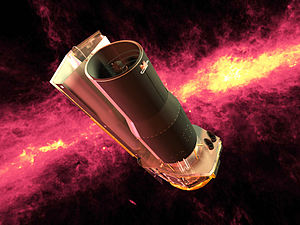Spitzer space telescope

Artist rendering of the Spitzer Space Telescope
|
|||||||||
| Names | Space Infrared Telescope Facility | ||||||||
|---|---|---|---|---|---|---|---|---|---|
| Mission type | Infrared space telescope | ||||||||
| Operator | NASA / JPL / Caltech | ||||||||
| COSPAR ID | 2003-038A | ||||||||
| SATCAT № | 27871 | ||||||||
| Website | http://www.spitzer.caltech.edu/ | ||||||||
| Mission duration | Planned: 2.5 to 5+ years Primary mission: 5 years, 8 months, 19 days Elapsed: 13 years, 4 months, 28 days |
||||||||
| Spacecraft properties | |||||||||
| Manufacturer |
Lockheed Ball Aerospace |
||||||||
| Launch mass | 950 kg (2,094 lb) | ||||||||
| Dry mass | 884 kg (1,949 lb) | ||||||||
| Payload mass | 851.5 kg (1,877 lb) | ||||||||
| Start of mission | |||||||||
| Launch date | 25 August 2003, 05:35:39 UTC | ||||||||
| Rocket | Delta II 7920H | ||||||||
| Launch site | Cape Canaveral SLC-17B | ||||||||
| Entered service | 18 December 2003 | ||||||||
| Orbital parameters | |||||||||
| Reference system | Heliocentric | ||||||||
| Regime | Earth-trailing | ||||||||
| Eccentricity | 0.02 | ||||||||
| Perihelion | 0.98 AU | ||||||||
| Apohelion | 1.02 AU | ||||||||
| Inclination | 0° | ||||||||
| Period | 363 days | ||||||||
| Epoch | 25 August 2003 04:35:00 | ||||||||
| Main telescope | |||||||||
| Type | Ritchey–Chrétien | ||||||||
| Diameter | 0.85 m (2.8 ft) | ||||||||
| Focal length | 10.2 m (33 ft) | ||||||||
| Wavelengths | infrared, 3.6–160 µm | ||||||||
|
|||||||||
|
|||||||||
| Instruments | |
|---|---|
| IRAC | Infrared Array Camera |
| IRS | Infrared Spectrograph |
| MIPS | Multiband Imaging Photometer for Spitzer |
The Spitzer Space Telescope (SST), formerly the Space Infrared Telescope Facility (SIRTF), is an infrared space telescope launched in 2003. It is the fourth and final of the NASA Great Observatories program.
The planned mission period was to be 2.5 years with a pre-launch expectation that the mission could extend to five or slightly more years until the onboard liquid helium supply was exhausted. This occurred on 15 May 2009. Without liquid helium to cool the telescope to the very low temperatures needed to operate, most of the instruments are no longer usable. However, the two shortest-wavelength modules of the IRAC camera are still operable with the same sensitivity as before the cryogen was exhausted, and will continue to be used in the Spitzer Warm Mission. All Spitzer data, from both the primary and warm phases, are archived at the Infrared Science Archive (IRSA).
In keeping with NASA tradition, the telescope was renamed after its successful demonstration of operation, on 18 December 2003. Unlike most telescopes that are named after famous deceased astronomers by a board of scientists, the new name for SIRTF was obtained from a contest open to the general public.
The contest led to the telescope being named in honor of astronomer Lyman Spitzer, who had promoted the concept of space telescopes in the 1940s. Spitzer wrote a 1946 report for RAND Corporation describing the advantages of an extraterrestrial observatory and how it could be realized with available or upcoming technology. He has been cited for his pioneering contributions to rocketry and astronomy, as well as "his vision and leadership in articulating the advantages and benefits to be realized from the Space Telescope Program."
...
Wikipedia

